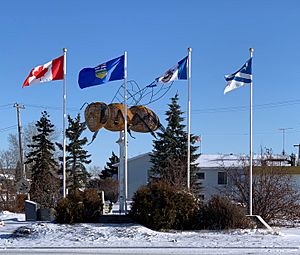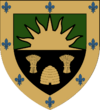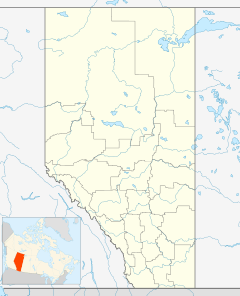Falher facts for kids
Quick facts for kids
Falher
|
|||
|---|---|---|---|
|
Town
|
|||
| Town of Falher Ville de Falher |
|||

The world's largest honey bee Statue
|
|||
|
|||
| Nickname(s): | |||
| Country | Canada | ||
| Province | Alberta | ||
| Region | Northern Alberta | ||
| Census division | 19 | ||
| Municipal district | Municipal District of Smoky River No. 130 | ||
| Incorporated | |||
| • Village | September 5, 1923 | ||
| • Dissolution | August 9, 1926 | ||
| • Village | March 13, 1929 | ||
| • Town | January 1, 1955 | ||
| Area
(2021)
|
|||
| • Land | 2.83 km2 (1.09 sq mi) | ||
| Elevation | 587 m (1,926 ft) | ||
| Population
(2021)
|
|||
| • Total | 1,001 | ||
| • Density | 354.1/km2 (917/sq mi) | ||
| Time zone | UTC−7 (MST) | ||
| • Summer (DST) | UTC−6 (MDT) | ||
| Area code(s) | +1-780 | ||
| Highways | Highway 49 Highway 2 |
||
Falher ( FƏ-lair) is a town in the Peace Country area of Alberta, Canada. It is located in the Municipal District of Smoky River No. 130, along Highway 49. Falher is one of the earliest agricultural communities in the Peace River Country and is notable for its sizable francophone population.
History
The area was known to missionaries before it was surveyed in 1909 as an Indian trail that led to British Columbia and later where the railway laid its tracks. In 1912, the settlement of Mission St-Jean Baptiste de Falher was opened 5 km (3.1 mi) from the current location of the Town of Falher. When the railway came to the area in 1915, the settlement was named after Father Constant Falher, a Roman Catholic Oblate missionary who was born in Josselin, Brittany, France in 1863, arriving at Grouard in 1889. The origin of the majority of local colonizers were from Quebec; some arriving in the area via the United States of America (French American), such as Robert Goulet's family, who settled in the nearby Village of Girouxville. The town still remains a dominantly francophone community.
The colony was divided into two: what is now the Village of Donnelly and the Town of Falher. In 1919, the town consolidated a school district and the first parish of Ste. Anne was established. The first post office opened in 1923 when the settlement became a hamlet. It incorporated as a village in 1929 and then as a town in 1955.
Demographics
| Federal census population history |
||
|---|---|---|
| Year | Pop. | ±% |
| 1926 | 128 | — |
| 1931 | 253 | +97.7% |
| 1936 | 284 | +12.3% |
| 1941 | 244 | −14.1% |
| 1946 | 279 | +14.3% |
| 1951 | 575 | +106.1% |
| 1956 | 802 | +39.5% |
| 1961 | 741 | −7.6% |
| 1966 | 843 | +13.8% |
| 1971 | 935 | +10.9% |
| 1976 | 1,120 | +19.8% |
| 1981 | 1,102 | −1.6% |
| 1986 | 1,178 | +6.9% |
| 1991 | 1,183 | +0.4% |
| 1996 | 1,149 | −2.9% |
| 2001 | 1,109 | −3.5% |
| 2006 | 941 | −15.1% |
| 2011 | 1,075 | +14.2% |
| 2016 | 1,047 | −2.6% |
| Source: Statistics Canada |
||
In the 2021 Census of Population conducted by Statistics Canada, the Town of Falher recorded a population of 1,001 living in 408 of its 474 total private dwellings, a change of -4.4% from its 2016 population of 1,047. With a land area of 2.83 km2 (1.09 sq mi), it had a population density of 353.7/km2 (916/sq mi) in 2021.
In the 2016 Census of Population conducted by Statistics Canada, the Town of Falher recorded a population of 1,047 living in 450 of its 482 total private dwellings, a -2.6% change from its 2011 population of 1,075. With a land area of 2.78 km2 (1.07 sq mi), it had a population density of 376.6/km2 (975/sq mi) in 2016.
Arts and culture
Every year, a "Honey Festival" is held to pay tribute to the beekeeping industry which has created an impact in the Smoky River region and throughout Canada and the United States. The honey in the area is derived largely from clover seed operations. At its peak, more than 48,000 hives in the region produced 10 million pounds (4,500 t) of honey annually. Today the honey of the Smoky River Region is known worldwide.
Falher attracted national attention in 2006 due to its high standing in the "Kraft Hockeyville" contest, a coast-to-coast competition to elect the municipality that most embodies the spirit of Canada's national pastime.
Attractions
Main Street Falher includes a large honey bee statue, as Falher is known as "Honey Capital of Canada". The statue was built by local welder, Richard Ethier and it measures 22 feet 8 inches (6.91 m), and its diameter is 7 feet 7 inches (2.31 m). There is also a tall slide next to an arena where the local hockey team, The Falher Pirates, play against other teams in the division.
Economy
The principal industries in the area are agriculture, forestry, oil and gas.
Established in 1973 as a private business, Falher Alfalfa (an alfalfa processing facility) was sold to a group of producers and farmers in 1978 with the same company. Under normal circumstances, Falher Alfalfa employed a staff of about 35 full-time employees in the spring and 110 at the busiest time of the season. Falher Alfalfa went under the Company Creditor Arrangement Act in June 2007, protecting the company against any legal action taken by creditors and gave the company a chance to sell its product to be able to repay creditors. In spring 2008, Falher Alfalfa declared bankruptcy due to production costs.
Education
There are two public schools in Falher:
- École Héritage School is a Francophone school that is located in a building that once served as a college school built by the Oblates in 1951. École Héritage currently has students in grades K–12.
- École Routhier School is another educational institution in Falher. Routhier is an Anglophone and French immersion Elementary School which includes grades K–6.
Students in grades 7-12 attend classes at École Georges P. Vanier School in nearby Donnelly, Alberta.




